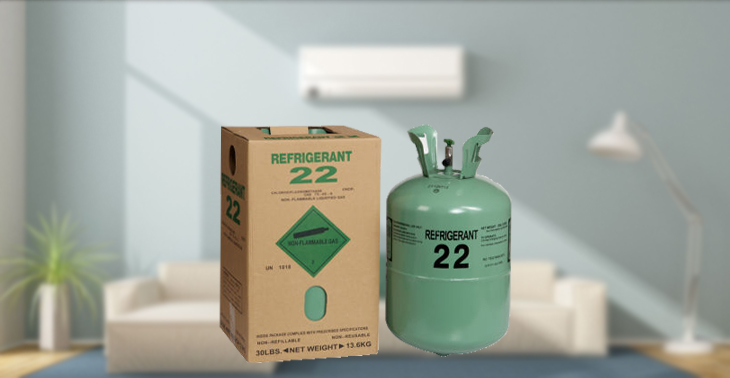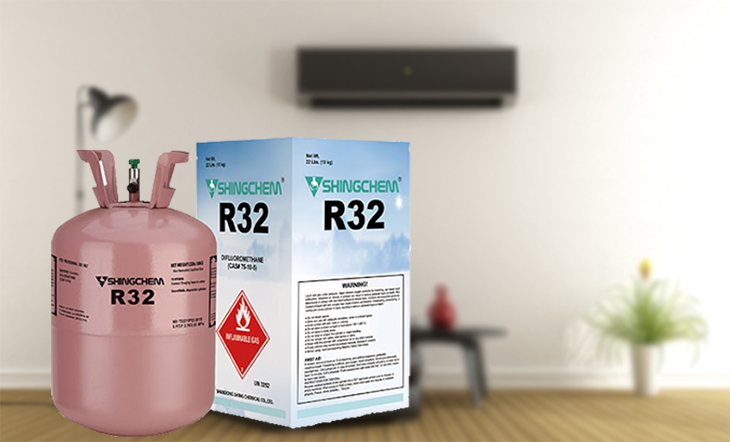1What is Air Conditioner Refrigerant?
Air conditioner refrigerant is a type of coolant that helps air conditioners work efficiently and produce cold air. The refrigerant gas continuously evaporates and condenses within the system, transferring heat from warmer to cooler areas.
The gas can change from a liquid to a gas and vice versa, depending on the pressure. When the refrigerant absorbs heat, it evaporates and becomes a gas. When it releases heat, it condenses and turns back into a liquid. This process helps air conditioners provide cool air to your space.
2Common Types of Air Conditioner Refrigerants
R22 Refrigerant
R22 was the first refrigerant used in air conditioners and is typically found in more affordable models from brands like Panasonic, Daikin, LG, Samsung, and Midea.
However, R22 is considered environmentally harmful due to its impact on the ozone layer. As a result, most manufacturers have discontinued its use and replaced it with alternative refrigerants such as R410A and R32.

R22 was the first refrigerant used in air conditioners.
Advantages:
- Easy maintenance as you don’t need to completely remove the old refrigerant when adding more.
- Non-toxic.
- Non-flammable.
- Affordable.
Disadvantages:
- It can deplete the ozone layer, leading to a ban on its use in some countries.
- Inefficient, resulting in higher electricity consumption due to a low compression index.
- While non-toxic, high concentrations of R22 can cause asphyxiation.

R22 is easy to maintain and cost-effective.
R410A Refrigerant
R410A is produced with similar chemical components to R22 but has a higher evaporation rate and reduced greenhouse effect, making it environmentally friendly and a popular replacement for R22.

R410A has similar chemical components to R22 but reduces the greenhouse effect.
Advantages:
- Offers 1.6 times higher cooling efficiency compared to R22.
- Provides deeper cooling and is more energy-efficient than R22-based systems.
- Environmentally friendly as it does not deplete the ozone layer.
Disadvantages:
- Requires storage in a well-ventilated area to prevent gas leakage.
- Difficult to maintain as any remaining gas must be removed before adding more.
- Air conditioners using R410A tend to be more expensive than those using R22.
- Higher costs for gas refilling and pumping compared to R22.

R410A offers higher cooling efficiency and is environmentally friendly.
R32 Refrigerant
R32 is the newest refrigerant on the market and is widely used in Japan. It was designed to replace R22 and R410A and is gaining popularity among consumers.

R32 is the most modern refrigerant available today.
Advantages:
- Meets environmental protection requirements, reducing emissions by up to 75%.
- Energy-efficient, providing faster and deeper cooling compared to R22 and R410A.
- Has a similar pressure to R410A, so if you’re switching from R410A, you only need to replace the charging gauge and charging hose.
Disadvantages:
- Difficult to install and maintain without the proper tools and gauges.
- Air conditioners using R32 tend to be more expensive than those using R22 or R410A.
- Higher costs for gas refilling, pumping, and replacement.

R32 is environmentally friendly and energy-efficient.
3Comparing Different Types of Air Conditioner Refrigerants
| Criteria | R22 | R410A | R32 |
| Individual Properties |
Non-toxic but can cause asphyxiation in high concentrations due to oxygen deprivation. Widely used in refrigeration, but it contributes to ozone depletion and the greenhouse effect. |
Non-toxic and environmentally friendly. | Meets GWP (550) emissions standards, reducing emissions by 75%. It’s environmentally friendly, doesn’t deplete the ozone layer, and is safe for human health. |
| Cooling Speed | Lower cooling efficiency compared to R410A and R32. | 1.6 times higher cooling efficiency than R22. | Operates quietly and delivers the highest cooling efficiency. |
| Power Consumption | High power consumption. | Energy-efficient and minimizes gas leakage during compression. | Has a COP index of up to 6.1, resulting in superior energy savings. |
| Repair and Refilling Costs | Low cost as it doesn’t require complete removal of old refrigerant when refilling. | Expensive refilling and pumping due to the need for specialized tools and skilled technicians. | Highest cost due to its modern technology and numerous advantages. |
| Safety | Safe, non-flammable. | Safe, low toxicity, non-flammable, and chemically stable. | Extremely safe, with a very low risk of flammability. |
Check out our air conditioner cleaning services for the best experience.
If you’re looking for convenient, quick, and reliable air conditioner cleaning services, look no further than our team. We’re here to help!
Benefits of Choosing Our Air Conditioner Cleaning Services:
- Free hotline: 1900 232 463
- 60-day warranty.
- Free gas inspection and refilling.
- Money-back guarantee if you’re not satisfied.
- Punctual service.
- Skilled technicians.
- Honest and transparent pricing.
- Friendly and cheerful service.

































